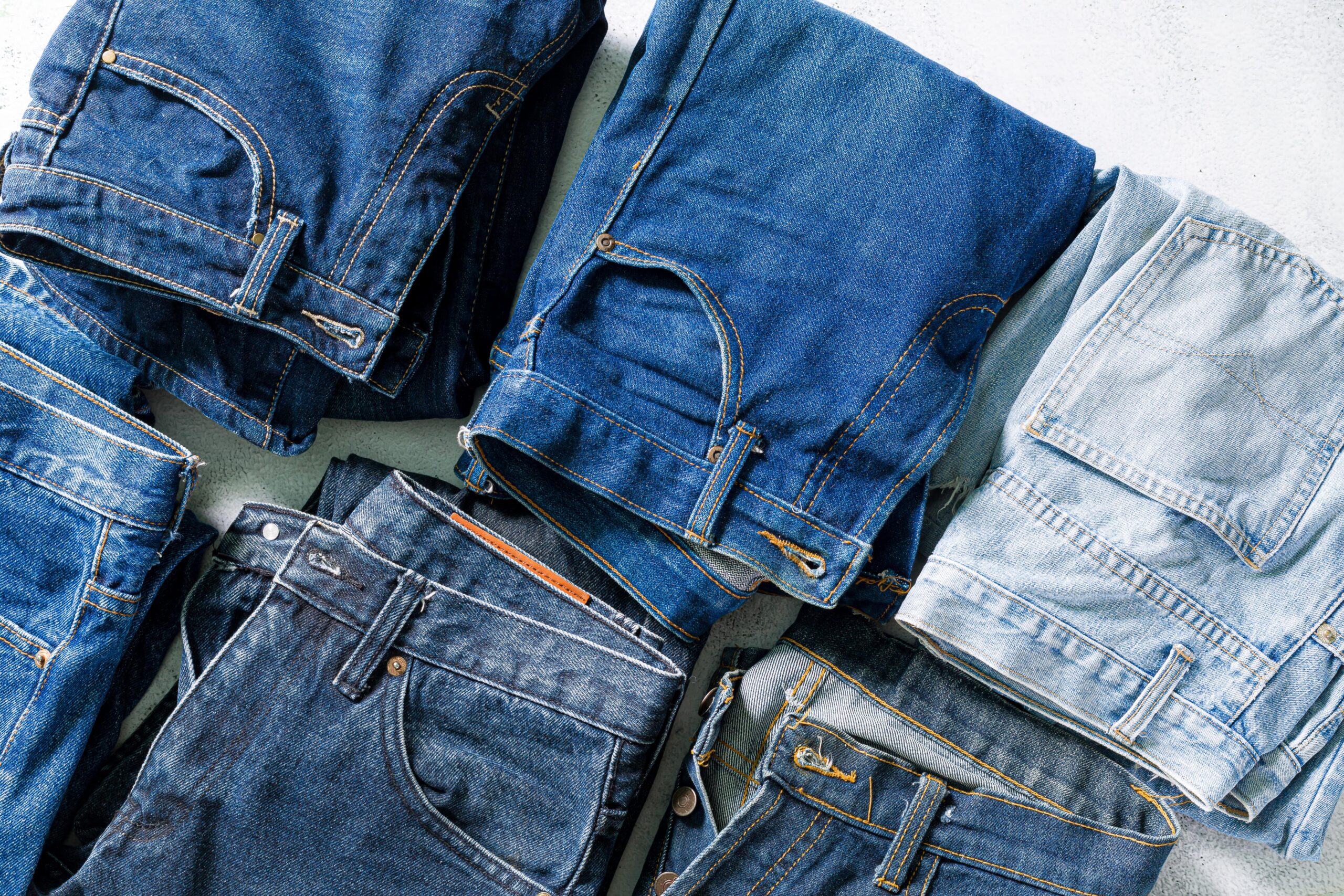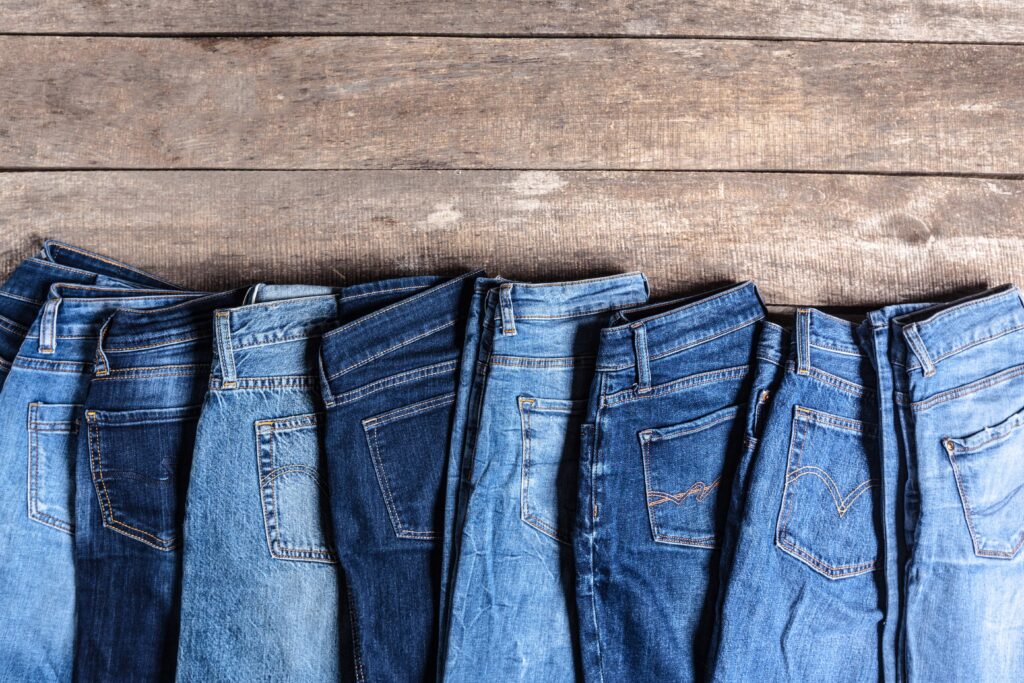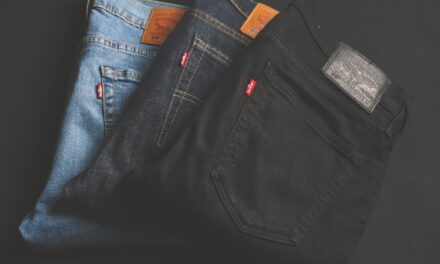Understanding the differences between women’s jean sizes compared to men’s in sizing, waist circumference, and inseam measurement is crucial.
Women’s jean sizes are typically smaller than men’s, and this variation stems from the distinct body shapes between genders. The fashion industry recognizes these disparities and has separate size standards for men and women, including stretch jeans.
Navigating through international sizing charts and jeans sizes can be a challenge, especially when each brand seems to have its own unique approach. For example, a size 6 in one brand may not necessarily correspond to the same waist circumference measurements as a size 6 in another brand. It all boils down to how each company interprets their sizing system.
To make matters more confusing, women often encounter additional labels like “small” or “extra small,” which further complicate finding the right pair of jeans.
However, fret not! In this guide, we’ll delve into the world of women’s jean sizes compared to men’s, unraveling the mysteries behind those numbers and inches. So let’s dive in and decode the secrets behind finding that perfect fit!
In addition to waist and hip measurements, inseam measurement is crucial when it comes to finding the right pair of denim. Women often encounter additional labels like “small” or “extra small,” which further complicate finding the right pair of jeans. However, fret not! In this guide, we’ll delve into the world of women’s jean sizes compared to men’s, unraveling the mysteries behind those numbers
Understanding Pants Sizing: Cuts and Fits for Men and Women:
Different Cuts and Fits for Men’s and Women’s Pants
Understanding the different cuts and fits available for both men and women is essential. Each gender has its own unique options, including pants size chart and jeans sizes. Ensuring that everyone can find a fit that suits their body type and personal style, with the help of jeans size charts and pant size.
For men, popular pants cuts include:
- Straight cut: A classic fit that runs straight from the hip to the ankle, featuring a comfortable waistband and available in various sizes according to the pants size chart and jeans size charts. Upgrade your wardrobe with our stretch jeans for ultimate style and flexibility.
- Bootcut: This style is fitted through the thigh and flares slightly from the knee down, allowing room for boots. Check our pants size chart to find the perfect fit for your waist size and pant size.
- Skinny: A close-fitting style that hugs the legs tightly, perfect for any pants size or waist size. Additionally, it accentuates the midsection.
- Relaxed fit: These pants offer a looser fit throughout the leg and midsection for maximum comfort. Find your perfect waist size with options ranging from ones to 48 inches.
On the other hand, women have a variety of cuts to choose from as well, depending on their pants size. They can find ones that flatter their midsection and suit their pant size.
- Slim fit: This cut is designed to be form-fitting without being overly tight, suitable for pants size, waist size, pant size, and leg length.
- Bootcut: Similar to men’s bootcut jeans, this style is fitted through the thigh but gradually widens below the knee to accommodate boots or heels. Available in various pants sizes, waist sizes, leg lengths, and inches.
- Skinny: Like men’s skinny jeans, this option provides a snug fit throughout the leg for pants size and waist size, in inches, for us women.
- Relaxed fit: Offering a looser silhouette than slim-fit or skinny jeans, these provide more room in the hips and thighs for US women, typically ranging from a few inches to several inches.
Various Fit Options
In addition to different cuts, both men’s and women’s pants offer various fit options such as high-rise, low-rise, or regular rise. These refer to where the waistband sits on your body, usually measured in inches. The right waistband height, measured in inches, can greatly impact how comfortable you feel in your pants.
For women:
- High-rise: The waistband, sitting above your natural waistline, provides extra coverage and support for us women, measuring in inches.
- Low-rise: The waistband sits lower on your hips, creating a more casual and relaxed look for us women. The waistband sits approximately a few inches lower on your hips, creating a more casual and relaxed look.
- Regular rise: This is a mid-rise option that sits just below your natural waistline, offering a balanced fit.
For men:
- Low-rise: The waistband sits lower on the hips for a modern and trendy look, perfect for us women.
- Regular rise: This classic option sits at the natural waistline, providing a comfortable fit for us.
- High-rise: Less common in men’s pants, high-rise options sit above the natural waistline for added coverage and support in the US.
Understanding these fit options allows us to choose pants that not only flatter our body shape but also cater to our personal preferences and comfort level.
Selecting the Right Pair of Jeans
Knowing the various cuts, fits, and rises available for both men’s and women’s jeans can make shopping for pants much easier. Here are some tips to help you find the perfect fit:
- Determine your body type in the US: Understanding your body shape will guide you in selecting cuts that complement your figure.
- Consider your style preference: Whether you prefer a more relaxed or form-fitting look, there is a cut and fit that suits every style for us.
Exploring the Variations Between Male and Female Pants Sizes:
Waist Measurements: The Key to Finding the Right Fit
Waist measurements are a crucial factor for both men and women. However, there are some variations in how these measurements affect sizing for each gender.
For men, waist measurements typically play a more direct role in determining their pants size. Most men’s pants are designed to fit around the natural waistline, which is usually located just above the hips. Therefore, when looking at a pants size chart for men, you’ll find that the waist measurement is often the primary indicator of which size to choose.
On the other hand, women’s pants sizes tend to be influenced by both waist and hip measurements. Women’s bodies naturally have wider hips compared to men’s, so designers take this into account when creating pants for women.
As a result, when you look at a women’s pant size chart, you’ll notice that hip measurements also come into play alongside waist measurements.
Hip Measurements: A Crucial Factor for Women
While hip measurements may not be as significant for men’s pants sizes, they are essential in determining the right fit for women. Since women generally have curvier figures with wider hips, designers create pants that accommodate this aspect of their body shape.
When comparing men’s and women’s jeans side by side, you’ll notice that women’s jeans often have more room in the hip area compared to men’s jeans of similar waist sizes. This extra space allows for a better fit around the hips without compromising comfort or style.
Inseam Length: Getting That Perfect Fit
Regardless of gender, inseam length plays a vital role in achieving well-fitting pants. The inseam refers to the distance from the crotch seam down to where your pant legs should end.
Both men and women come in different shapes and heights, so inseam lengths vary accordingly. However, it’s crucial to note that inseam length is not directly related to waist or hip measurements. Instead, it focuses on the vertical length of the pants.
To find your ideal inseam length, consider the following options:
- Regular: Typically designed for individuals of average height.
- Short: Ideal for shorter individuals who need a slightly shorter pant length.
- Long: Suited for taller individuals who require extra length in their pants.
Understanding these variations between male and female pant sizes can help you avoid the frustration of ill-fitting jeans. By paying attention to waist and hip measurements, as well as finding the right inseam length, you’ll be able to select pants that flatter your body shape and provide optimal comfort.
So next time you’re shopping for new jeans, consult a pants size chart that takes into account these differences. Remember, finding the perfect fit is all about understanding how different measurements work together to create an ideal pair of pants tailored specifically for you.
Now go rock those jeans with confidence!
Impact of Women’s Jeans Cuts on Sizing and Different Fitting Options:
More Choices for Women
Women have a wider range of cut options compared to men. This means that women can find the perfect fit that suits their body shape and size. Let’s explore some of the different fitting options available for women’s jeans.
Curvy Fits for Fuller Hips
One popular option for women is the curvy fit. These jeans are designed to accommodate fuller hips while still maintaining waist definition. They provide extra room in the hip area, ensuring a comfortable fit without sacrificing style. Curvy fits are perfect for those who want a flattering silhouette that highlights their curves.
Some examples of curvy fit jeans include:
- [Brand A] Curvy Skinny Jeans
- [Brand B] Curvy Bootcut Jeans
- [Brand C] Curvy High-Waisted Jeans
Petite Fits for Shorter Heights
For shorter individuals, finding jeans with the right proportions can be challenging. That’s where petite fits come in handy. Petite jeans are designed specifically for shorter heights, offering adjusted inseams and proportions to ensure a proper fit.
Here are some options for petite fit jeans:
- [Brand X] Petite Straight Leg Jeans
- [Brand Y] Petite Boyfriend Jeans
- [Brand Z] Petite Flare Leg Jeans
With these options, shorter women no longer have to worry about hemming or altering their jeans to get the right length.
Tall Fits for Longer Inseams
On the other end of the spectrum, tall individuals often struggle to find jeans with long enough inseams. That’s where tall fits come into play. These jeans offer longer inseams, catering to taller individuals who need extra length in their pants.
Consider these tall fit options:
- [Brand P] Tall Skinny Jeans
- [Brand Q] Tall Wide-Leg Jeans
- [Brand R] Tall Bootcut Jeans
Tall fits ensure that taller women can find jeans that fit them properly without looking too short.
Embracing Skinny and Stretch Options
Two popular styles are skinny jeans and stretch jeans. Skinny jeans hug the legs closely from waist to ankle, creating a sleek and stylish look. On the other hand, stretch jeans offer added flexibility and comfort with their stretchy fabric.
Whether you prefer skinny or stretch options, these fits are available across various cuts, including curvy, petite, and tall. So you can enjoy the benefits of both style and comfort in your preferred fit.
Decoding Women’s Pants Sizes: What to Look For:
Pay Attention to Numeric Sizing
Understanding the numeric sizing is crucial. Unlike men’s jeans that typically use waist measurements in inches or centimeters, women’s jeans often use a numbered system that can be confusing at first. The number on the tag represents the waist measurement, but keep in mind that different brands may have slight variations in their size charts.
To find the perfect fit, pay close attention to the numeric sizing and measure your waist accurately. If you’re unsure about your size, take a measuring tape and wrap it around your natural waistline, which is usually located just above your belly button. This will give you an accurate measurement to compare with the size chart provided by the brand.
Check for Inseam Length and Leg Opening Width
Apart from the waist measurement, women’s pants sizes may also indicate information about inseam length or leg opening width. Inseam length refers to the distance from the crotch seam down to the hem of the pants. It determines where the pants will fall on your legs. Leg opening width indicates how wide or narrow the bottom of the pant leg is.
If you have a specific preference for how long or short you want your pants to be, pay attention to these details when choosing a size.
Some brands offer different inseam options for petite, regular, and tall lengths. Similarly, leg opening widths can vary depending on whether you prefer a skinny fit or a wider bootcut style.
Understand Brand Variations
It’s important to note that different brands may have varying size charts despite using similar numbers. While one brand’s size 8 might fit perfectly, another brand’s size 8 could be too loose or too tight. This discrepancy occurs due to differences in design philosophy and target demographics.
To navigate this challenge effectively, it’s always advisable to consult the brand’s size chart before making a purchase. Reading customer reviews and feedback can provide valuable insights into how a particular brand’s sizing runs.
Keep in mind that finding the right fit might require trying on multiple sizes within a brand due to potential inconsistencies.
Consider Trying Multiple Sizes
There is no one-size-fits-all solution. Even within the same brand, you may find variations in fit between different styles and cuts. To ensure you find the perfect pair of jeans, consider trying on multiple sizes when shopping.
Start with your usual size based on your waist measurement, but don’t be afraid to experiment with other sizes as well. Sometimes going up or down a size can make all the difference in achieving the desired fit. Remember that each body is unique, and what works for someone else may not work for you.
Conversion Guide: Men’s to Women’s Jeans Size Chart
Understanding the Differences
It can be a struggle for both men and women. However, one area that often causes confusion is the difference in sizing between men’s and women’s jeans. While it may seem like a simple conversion, there are some key factors to consider when trying to find the right fit.
The Importance of a Jeans Size Chart
To make the process easier, many brands provide jeans size charts. These charts help you understand the measurements associated with each size, allowing you to find your perfect fit. When using a jeans size chart, keep in mind that they typically differ between men and women due to variations in body shape and proportions.
Converting Men’s Sizes to Women’s Sizes
If you’re a woman looking for jeans in the men’s section or vice versa, here’s a handy conversion guide:
- Start by determining your waist measurement in inches.
- For women converting to men’s sizes:
- Subtract 21 from your waist measurement.
- Divide the result by 2.
- Round down to the nearest whole number.
- This will give you your corresponding men’s jean size.
- For men converting to women’s sizes:
- Multiply your waist measurement by 2.
- Add 21 to the result.
- This will give you your corresponding women’s jean size.
It’s important to note that these conversions are not always exact since different brands may have slight variations in their sizing charts. Therefore, it is recommended to try on different sizes within a range for an accurate fit.
Tips for Finding Your Perfect Fit
While using a conversion chart can be helpful, there are additional tips you should keep in mind when shopping for jeans:
- Try on multiple sizes: Different brands have different fits and cuts, so don’t be afraid to experiment with various sizes.
- Consider body shape: Women’s jeans often have a narrower waist and wider hips compared to men’s jeans. Understanding your body shape can help you find the right style and fit.
- Look for stretch: Many jeans now come with added stretch, which can provide a more comfortable fit. Consider opting for styles that offer some flexibility.
- Read customer reviews: Before making a purchase, take the time to read customer reviews online. This can give you valuable insights into how a particular brand or style fits.
Remember, finding the perfect pair of jeans is not just about the size but also about how they make you feel. Don’t be discouraged if it takes some trial and error to find your ideal fit – everyone’s body is unique!
Comprehensive Women’s Jeans Size Chart for Easy Reference:
Determining the Right Fit
So, you’re on the hunt for a pair of jeans that fit just right? Look no further! Our comprehensive women’s jeans size chart is here to save the day. With this handy guide, you’ll be able to find the perfect fit based on your waist and hip measurements. Let’s dive in!
The Basics: Waist and Hip Measurements
Understanding your waist and hip measurements is crucial. To measure your waist, wrap a tape measure around the narrowest part of your torso, usually just above your belly button. For accurate results, make sure you’re not sucking in or pushing out your tummy!
Next up is measuring your hips. Wrap the tape measure around the widest part of your hips, typically around 7-9 inches below your waistline. Remember to keep the tape parallel to the ground for precise measurements.
Decoding the Size Chart
Now that you have your waist and hip measurements handy, let’s decode our women’s jeans size chart. This chart will help you determine which size corresponds to your unique body shape.
- Waist Sizes: The chart will list various numerical sizes corresponding to different waist measurements. Find your actual waist measurement and match it with the corresponding size.
- Inseam Measurement: Another important factor when choosing jeans is inseam length—the distance from crotch to hem along the inside seam of the leg. Our size chart may include information on inseam lengths so you can find a pair that hits at just the right spot.
- Rise and Leg Opening Width: Some charts might provide details about rise (the distance between crotch and top of jeans) as well as leg opening width (the circumference at the bottom hem). These specifications ensure a comfortable fit throughout.
Brand Variations
It’s essential to note that different brands may have their own unique size charts. So, while our comprehensive chart is a great starting point, it’s wise to refer to each brand individually. Don’t be discouraged if you find that your size varies across different brands—it’s a common occurrence!
Why Use a Size Chart?
Using a women’s jeans size chart can save you time and ensure a better fit when shopping for denim. Instead of trying on multiple pairs in-store or dealing with the hassle of returning ill-fitting online purchases, you can confidently select the right size from the get-go.
Online shops often provide detailed size charts for each product, making it easier to shop from the comfort of your home. By knowing your waist and hip measurements and referring to the appropriate chart, you’ll be one step closer to finding that perfect pair of jeans.
So, next time you’re on the hunt for new denim, remember to consult our comprehensive women’s jeans size chart. It’s your secret weapon for finding jeans that fit like a dream!
Conclusion
Understanding the differences in women’s jean sizes compared to men’s is crucial for finding the perfect fit and style. By exploring the variations between male and female pants sizes, we can decode women’s pants sizes and provide helpful conversion guides.
Cuts and fits play a significant role for both men and women. Women’s jeans come in different cuts such as skinny, straight, bootcut, and flare, while men’s jeans are typically categorized as slim, straight, relaxed, or loose. These variations in cuts affect how the jeans fit on different body types.
The impact of women’s jeans cuts on sizing leads to different fitting options. For example, skinny jeans tend to have a tighter fit throughout the leg, while bootcut jeans offer more room at the calf area. It is important to consider these factors when choosing the right pair of jeans.
Decoding women’s pants sizes can be challenging due to inconsistent sizing standards across brands. However, by knowing what to look for in terms of waist measurement and inseam length, you can navigate through the size charts more effectively.
To make things easier, we provide a comprehensive conversion guide from men’s to women’s jean sizes. This chart allows you to compare waist measurements and find your corresponding size in women’s jeans based on your preferred men’s size.
FAQs
Q: Are women’s jean sizes smaller than men’s?
A: Women’s jean sizes are typically not smaller than men’s; they follow a different sizing system based on waist measurements rather than traditional numeric values used for men’s jeans.
Q: Can I use my men’s jean size to determine my women’s jean size?
A: While men’s and women’s jeans have different sizing systems, you can use a conversion guide to find your corresponding size in women’s jeans based on your preferred men’s size.
Q: Do women’s jeans have different cuts compared to men’s jeans?
A: Yes, women’s jeans come in various cuts such as skinny, straight, bootcut, and flare, while men’s jeans are typically categorized as slim, straight, relaxed, or loose. These cuts affect how the jeans fit on different body types.
Q: How do I measure myself for women’s jeans?
A: To measure yourself for women’s jeans, you need to determine your waist measurement and inseam length. Measure around the narrowest part of your waist and from your crotch down to the desired length of the pants.
Q: Why are there inconsistencies in women’s jean sizes across brands?
A: Inconsistencies in women’s jean sizes across brands arise due to differing interpretations of sizing standards. Each brand may have its own unique approach to sizing and fit, making it important to consult specific size charts when shopping for jeans.













